Each NSM has a 100+ nautical mile (115 mile/185 kilometer) range and is equipped with advanced sensors to circumvent and evade enemy ship radars and, if required, also can target specific areas of an adversary’s warship. Thus, would it not be logical to replace the eight RGM-84 Harpoon Anti-Ship missiles mounted on the U.S. Navy’s Arleigh Burke-class destroyers with NSMs for better Anti-Ship missile armament? Naval News asked the U.S. Navy for answers.
According to the SEAPOWER 2021 Almanac, the air, sea, and submarine-launched “autonomous, all-weather, over-the-horizon sea-skimming active-radar guided Harpoon Anti-Ship cruise missile has been upgraded a few times, with the latest upgrade, the Harpoon Block II+ having a new GPS guidance kit, improved weapon survivability and reliability, and a new data-link interface that allows for in-flight updates and improved target selection. The Harpoon is deployed onboard U.S. Navy attack submarines and surface combatants (cruisers, destroyers, one littoral combat ship [RGM-84]) as well as on FA/18, F/A-18E/F, P-3 and P-8 aircraft [AGM-84].”
The standard high-subsonic RGM-84 Harpoon Anti-Ship cruise missile has a range of 67 nautical miles (77 miles/107 kilometers) and carries a 488 pounds (221 kilograms) high-explosive blast penetration warhead.

Each Arleigh-Burke-class AEGIS destroyer (and Ticonderoga-class AEGIS cruiser) has a quad mount for four RGM-84 Harpoon ASMs (stacked two-by-two) at the rear of the ship. Another quad mount faces the other way for a total of eight Harpoon ASMs. In peacetime, these Harpoons are a potent weapon, able to deter aggression and provide standoff range against all surface ships. However, in wartime, the range, speed, and technological advantages of the Harpoon ASM, first-fielded in 1977, come into question against newer and more advanced adversary warships’ radars, Anti-missile missiles, Close-in Weapons Systems (CIWS), rapid-fire guns, jammers, Electronic Countermeasures, and Anti-missile decoys.
A Naval News article mentioned in 31 January 2019 that, “The upgrade kits are used to turn older Harpoons into the latest version dubbed “RGM-84Q-4” or Block II+. This version of Harpoon has a range of 133.9 nautical miles (154 miles or 248 kilometers), an all-weather radar homing guidance system and a new, lighter but more lethal warhead.”
Naval News asked the U.S. Navy’s Chief of Information Department (CHINFO) in August 2021 on if the U.S. Navy intends to replace the aging Harpoon Anti-Ship missiles (ASM) aboard its AEGIS Arleigh-Burke class destroyers, and if the U.S. Navy intends to have the Naval Strike Missile (NSM) be able to launch vertically from the Vertical Launch System (VLS) aboard U.S. Navy warships and submarines.

U.S. Navy Lieutenant Lewis Aldridge of CHINFO replied to all three (questions) in stating:
“There are no plans to incorporate the Naval Strike Missile on destroyers or submarines.”
U.S. Navy Lieutenant Lewis Aldridge of CHINFO
Update 08/08/2021
Naval News’ Turkey-based contributor and former sailor Tayfun Ozberk provided the following data regarding the Harpoon anti-ship missile:
- 67 nautical miles is the range of the first Harpoon version: RGM-84A Block 1.
- Later versions such as Block 1C; Block 1G and Block II have a range of 75 nautical miles.
- 488 Lbs is the weight of the warhead. The warhead itself carries 215 Lbs of DESTEX explosive






